Healing Your Core After Baby: What Every Mom Needs To Know About Diastasis Recti
Diastasis recti or abdominal separation is common among postpartum women. This blog post discusses diastasis recti, including exercises that help heal the core.
TENDER LOVING CARE FOR MOMS & KIDS
Sheri Anne Maximille Cabañes-Madayag
7/13/20257 min read


Disclaimer: This blog post is based on personal and professional experience and is intended for informational and educational purposes only. This is not a substitute for professional medical advice, diagnosis, or treatment. Always consult with your healthcare provider for specific questions or concerns regarding your health.
Hello, beautiful mamas!
Have you ever looked at your belly in the mirror and thought, "I still look pregnant."
One possible explanation for this could be diastasis recti.
"Dia.. What?"
I know, the term sounds complicated, but let me break it down for you as a nurse who's been a postpartum mom. In this blog post, I'll discuss what diastasis recti is, how to know if you have one, and exercises that help heal your diastasis recti. Keep reading to learn more.
What You’ll Learn in This Post
What Is Diastasis Recti?
Diastasis recti (DR) refers to the separation of the abdominal muscles, particularly the rectus abdominis muscles or commonly known as the "six pack". Your rectus abdominis muscles are divided into left and right by a band of tissue called the linea alba.
Diastasis recti happens in up to 60% of pregnant and postpartum women. During pregnancy, the growing baby causes the belly to expand. As the belly expands, the linea alba naturally thins out, causing the separation of the rectus abdominis muscles.
After delivery, the linea alba can gradually heal and come back together. But in some cases, the gap in the abdomen does not fully close. If the gap is more than 2 centimeters (2 finger-widths), this is called diastasis recti.


Symptoms of Diastasis Recti
A visible bulge or “pooch” that protrudes just above or below the belly button
Coning or "doming" belly when contracting the ab muscles
Softness or jelly-like feeling around the belly button
Lower back pain
Poor posture
Weakness in the core muscles
Complications of Diastasis Recti
If left untreated, diastasis recti can lead to some complications:
Back pain
Pelvic pain
Damage to posture and mobility
Urinary and bowel incontinence
Hernia, in extreme cases
It is best to consult your doctor for proper diagnosis and treatment if you think you have diastasis recti.
How to Check for Diastasis Recti
Below is a simple self-check you can do at home to know if you might have diastasis recti:
Lie on your back with knees bent and feet flat on the floor.
Put one hand behind your head for support. The other hand on your belly, just above the belly button, to feel for the separation.
Slightly lift your head off the ground as if you're doing a crunch.
Use your fingers to feel for a gap between the abdominal muscles. Starting from your upper belly, then moving down to the lower belly.
See how many fingers can fit between the gap in your abdominal muscles. If you can fit more than two finger-widths into the gap, you likely have diastasis recti.
Remember to always consult your doctor for an accurate assessment and diagnosis.
Can Diastasis Recti Be Treated?
If you felt a gap between your ab muscles, don't panic. Diastasis recti is common and treatable. In some cases, diastasis recti may heal on its own within 12 months after giving birth, as the abdominal muscles regain strength. If your abdominal separation has not healed after a year, or if you're feeling any symptoms, consult your doctor for proper diagnosis and treatment.
Most recommended management for diastasis recti includes lifestyle modifications, weight loss, and physical therapy. Your doctor will most likely refer you to a physical therapist who will guide you through exercises that will help heal your diastasis recti.
If the diastasis recti does not improve after about 8 weeks of exercise therapy, surgery may be needed to repair the diastasis recti. During a diastasis recti surgery, the surgeon reconnects the muscles by itself or as part of an abdominoplasty or “tummy tuck” procedure.
Gentle Exercises To Help Heal Your Core
When I planned to lose weight a year after giving birth, I consulted my OB-GYN to check if I had diastasis recti. I also wanted to be sure it is safe to start an exercise program. Fortunately, I did not have diastasis recti, although I had more than a finger-width separation near my belly button. My doctor advised me to start with gentle walking and exercises to strengthen my core.
Below are some exercises that helped heal my core:
Umbrella breathing or 360-degree breathing
Stand with knees slightly bent, or sit on a yoga mat, floor, or chair.
Tighten your core from the lower belly going up, as if you're zipping up your pants. Maintain this core engagement as you breathe in and out.
As you inhale, allow the rib cage to expand in a 360-degree motion (front, back, and sides) or like an umbrella opening.
As you exhale, tighten your core and draw your rib cage back, like an umbrella closing.
Kegel or Pelvic Floor Exercise
Contract your pelvic floor muscles as if you're trying to stop yourself from peeing.
Hold for 10 seconds and release for 10 seconds. Then repeat.
Aim to complete 10-20 repetitions per set, 2-3 times a day.
Lie on your back with knees bent and feet flat on the floor.
Press your lower back against the floor, then gently tilt your pelvis upward while engaging your core.
Hold for 5-10 seconds. Repeat for 10-20 times a day.
Lie on your back with your left leg straight, your right knee bent, and your right foot flat on the floor.
Flatten your lower back against the floor and engage your core.
Bend your left knee by sliding your left foot across the floor toward your hip.
Slide your left foot back to straighten the left leg.
Repeat 8-12 times. Then switch legs and repeat for 8-12 times.
Lie flat on your back with knees bent and feet flat on the floor.
Tighten your core. Maintain core engagement as you do the exercise.
Gently bring both legs up, one at a time, in a tabletop position. Your knees should be at a 90-degree angle and your shins parallel to the floor.
Slowly lower your right foot down, tapping your right toe to the floor. Then, bring it back up to tabletop position.
Repeat with your left foot.
Do this 10 times with each leg.
Always remember to start slow. Listen to your body. Rest if you feel tired or have any discomfort. It is best to consult your doctor or a physical therapist specialized in postpartum exercises before starting an exercise regimen.
It takes about 8 weeks of regular exercise before you notice improvements in your core healing and strength. Consult your doctor if you don't see any improvement in your diastasis recti.


Exercises To Avoid If You Have Diastasis Recti
It can be tempting to do intense ab workouts to heal your core and lose weight quickly. But rushing things can cause more harm than good.
Certain exercises can make diastasis recti worse. These should be avoided until your abdominal separation has healed or modified according to your progress.
🚫 Traditional crunches and sit-ups directly engage your rectus abdominis muscles and push your abdominal muscles outward, which can separate them farther apart.
🚫 Planks and push-ups put too much pressure on your linea alba, which can add strain on your core.
🚫 Heavy lifting or lifting anything heavier than your baby can strain your core. Start with lighter weights, then slowly progress to heavier weights until your core is stronger.
🚫 Twisting movements like Russian twists and bicycle crunches can worsen the separation by putting excessive pressure on the linea alba.
🚫 Any exercise that causes "doming". If you see your belly "doming" or bulging outward into a cone shape while doing any exercise, stop immediately.
One tip that has helped me check if I can progress to more difficult exercises is to observe my core while doing any exercise moves. You can place a mirror near you or ask someone to take a video of your belly while exercising. If you see coning or doming in your belly, avoid or modify the exercises.
Listen to your body. I strongly recommend working with a postpartum exercise expert to ensure safety and proper core healing.
Kindness Throughout Your Core-Healing Journey
With so many expectations placed on moms, it's easy to feel pressured and to want quick results. Weight loss and "bouncing back" to prepregnancy state are among these expectations. Check out my blog post on postpartum weight loss for more information.


Always keep in mind that healing takes time. The last thing you need in your healing journey is being hard on yourself. Rushing and pushing yourself way past your limits can do more harm than good. Slow progress and consistency always beat intensity.
You don't have to do this alone. You can consult your doctor or a postpartum exercise expert to guide you through your recovery. Seek support from your family, friends, and other postpartum moms as you navigate through the journey of core-healing. You got this, beautiful mama.
Your body just accomplished something wonderful. That is, giving birth to a human being. Give your body the time, patience, and kindness it needs as it heals and recovers. Your strength does not just lie in your body or your abdominal muscles, but most importantly, in your heart.
How are you in your core-healing journey? I'd love to hear your progress and cheer you on.
Feel free to get in touch with me through my contact page.
Note: This post is for informational purposes only and is not a substitute for professional medical advice. Please speak with your healthcare provider about your specific health concerns.
